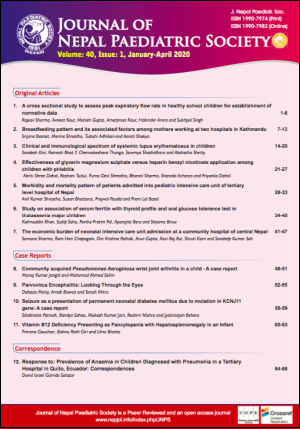Effectiveness of Glycerin Magnesium Sulphate Versus Heparin Benzyl Nicotinate Application Among Children with Phlebitis
DOI:
https://doi.org/10.3126/jnps.v40i1.28659Keywords:
Glycerin; Heparin Benzyl Nicotinate; Magnesium Sulphate; PhlebitisAbstract
Introduction: Phlebitis is the most common complication of intravenous infusion therapy. Incidence of phlebitis in children receiving intravenous therapy has been reported to be as high as 71.25%. The study was done to find out the effectiveness of glycerin magnesium sulphate versus heparin benzyl nicotinate application in children with phlebitis.
Methods: A pre-post control group design was used. A total of 43 subjects were randomly assigned into two groups [22 in experimental (glycerin magnesium sulphate application) and 21 in control (heparin benzyl nicotinate application) group] by lottery method. Data was collected using Modified Visual Infusion Phlebitis (VIP) Score.
Results: The comparison between VIP score was based on observations made before the interventions and at 12, 24, 36 and 48 hours after the intervention. Independent t tests showed significant difference in reduction of VIP score in experimental and control group after 12 hours and 24 hours of intervention. The study demonstrated that there is no statistically significant difference in reduction of VIP score among the subjects in experimental and control group at 12 hours (p = 0.219), 24 hours (p = 0.349), 36 hours (p = 0.695) and 48 hours (p = 0.424) after the intervention.
Conclusion: The study concludes that both glycerin magnesium sulphate and heparin benzyl nicotinate can be used effectively among children with phlebitis. However, after 24 hours of phlebitis, an alternative intervention needs to be used.
Downloads
Downloads
Published
How to Cite
Issue
Section
License
Authors who publish with this journal agree to the following terms:
Authors retain copyright and grant the journal right of first publication with the work simultaneously licensed under a Creative Commons Attribution License that allows others to share the work with an acknowledgement of the work's authorship and initial publication in this journal.
Authors are able to enter into separate, additional contractual arrangements for the non-exclusive distribution of the journal's published version of the work (e.g., post it to an institutional repository or publish it in a book), with an acknowledgement of its initial publication in this journal.
Authors are permitted and encouraged to post their work online (e.g., in institutional repositories or on their website) prior to and during the submission process, as it can lead to productive exchanges, as well as earlier and greater citation of published work (See The Effect of Open Access).



